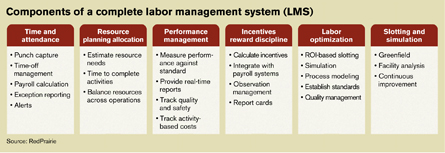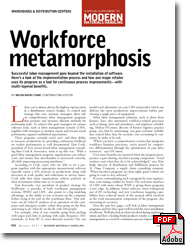Labor management systems to improve efficiency
Successful labor management goes beyond the installation of software. Here’s a look at the implementation process and how one major retailer uses its program as a tool for continuous process improvements—with multi-layered benefits.
Latest Material Handling News
Registration open for Pack Expo International 2024 Walmart chooses Swisslog AS/RS and software for third milk processing facility NetLogistik partners with Vuzix subsidiary Moviynt to offer mobility solutions for warehouses Lucas Watson appointed CSO for Körber’s Parcel Logistics business in North America Hyster recognizes Dealers of Distinction for 2023 More NewsLabor cost is almost always the highest expense item in a distribution center’s budget. To control and manage this cost, visionary managers often rely on comprehensive labor management programs that promote and measure efficient methods for performing tasks. To achieve this goal, managers tie various software tools, such as labor management systems (LMS), together with strategies to monitor, report and reward actual performance against established expectations.
These programs certainly aren’t new, and their ability to increase productivity by providing continuous feedback on worker performance is well documented. Don Cook, president of New Jersey-based labor management consulting firm Cook & Associates, sums it up this way: “With a good labor management program, organizations can reduce costs and ensure that merchandise is processed correctly, all while improving processing timeliness.”
According to Cook, users who are able to tie a program together with the appropriate measurement software typically report a 20% increase in productivity along with increases in work quality and reductions in service times. Cook adds that many organizations achieve payback on their investment within nine to 16 months.
Tom Kozenski, vice president of product strategy for RedPrairie—a provider of both warehouse management systems (WMS) and LMS—also points to a big modeling advantage, or the ability to test scenarios on the computer before trying it for real on the warehouse floor. “Our software can do ‘what-if’ analyses of an operation on the computer and anticipate results, rather than going on the floor and trying to do ‘what-ifs’ on the fly with 100 people.”
For example, what if you consider going from picking with paper pick lists to picking with radio frequency (RF) terminals, or from RF to voice-directed systems? You can model each alternative on your LMS and predict which one delivers the most productivity improvements before purchasing a single piece of equipment.
Other labor management solutions, such as those from Kronos, have also automated workforce-related processes such as hiring, time and attendance, and employee scheduling. Malysa O’Connor, director of Kronos’ logistics practice group, says that by automating, you gain real-time visibility into critical labor data for accurate cost accounting by customer, by order or by task.
Even more benefits are reported when the program incorporates a gain-sharing, incentive-paying component. “Good workers want what they do to be acknowledged,” says Matt Kulp, director of distribution and fulfillment projects for St. Onge Company, a supply chain consulting company. “When incentive programs are done right, good workers are going to want to stay onboard.”
If you’re contemplating such a program for your organization, your timing couldn’t be better. The real-time interface of LMS with more robust WMS is giving these programs a new edge. In addition, better software, more widespread use of RF technology, and new warehouse mapping capabilities have reduced much of the manual effort involved in the work measurement component of the program, also increasing its accuracy.
Over the next few pages, we’ll look at labor management programs and how they span well beyond the mere installation of software. We’ll also look at what’s involved during implementation and how a leading bridal products retailer is using labor management as a tool for continuous process improvements.
5 things to know
Getting the most out of your workforce depends on a sound and effective labor management program. Here are five crucial points to keep in mind when implementing one.
First: Strategy must be defined. Why are you doing it? Do you want to set standards for yearly budgetary planning or implement an employee measurement or incentive pay system where you’re rewarding people at the individual level? “These two extremes require different levels of software, different levels of sophistication, ongoing maintenance, and a lot of effort and cost to implement,” says St. Onge’s Kulp. “You need to understand what you’re trying to get out of it first so you can pick the right software and pick the proper approach.”
Second: A labor management program is more than just the installation of software. “It’s a total cultural change,” explains Cook. “It requires thorough knowledge of your operations, accurate work measurement, and an effective structure of reporting that promotes feedback.”
In fact, the actual software installation itself can take 30 minutes, but many other steps must also be accomplished. Critical, labor-intensive tasks in the DC must be identified and the length of time it takes to accomplish these tasks is recorded by the actual timing of employees as they perform each task, or by using a database of pre-determined time standards. Once standards are established and the system is online, managers must be trained to coach poor performers and resolve barriers to productivity.
An incentive payment component often takes the program to the next level by rewarding good performers as part of a management plan to share the savings gained. “Incentive policies can be powerful tools because they put employees in control of their own destinies,” says Kronos’ O’Connor. “Management needs to clearly communicate expectations and put in place a consistent system that employees can trust is fair.”
Third: It’s tough to manage without software. “You could get by for a while without software in a very small organization, say 50 employees or less,” says Cook. “However, you may have to employ more managers than necessary to try to keep track of what’s going on. In this day and age, as DCs and fulfillment centers become larger and more complex, you generally need the software because of the enormity of the data that you’ll be collecting and monitoring.”
Fourth: Expect cultural challenges. In cases of union involvement, it might be wise to get them involved from the very beginning, says Lisle Holgate, product marketing manager for RedPrairie’s workforce management platform. “Unions tend to support standardization when its members’ performance is based on a reasonable time to do the task in a safe and efficient manner.” Kozenski adds that some unions have engineers who will validate these standards as part of this process.
Fifth: Don’t install a program and proclaim you’re done. “You’re never done,” says Kozenski. “You’re always peeling the onion. You’re always looking for better ways to improve your operation.” The program must be flexible enough to quickly change as you change your methods and procedures. As a result, it’s imperative to keep maintenance costs in mind going forward. Depending on the number of employees and the number of facilities, one or an entire staff of engineers may be needed.
With these key points in mind, let’s see how David’s Bridal, the biggest U.S. retailer of “everything-weddings,” implemented its labor management program.
Measuring David’s Bridal
Planning a wedding? Look no further than David’s Bridal, the country’s largest bridal retailer, offering the convenience of one-stop shopping for wedding-related products and services from its 300 brick-and-mortar stores and its Web site.
However, Tony Coccerino, vice president of logistics and distribution, will be the first to tell you that this success would not be possible without the retailer keeping a close eye on labor costs within their two DCs in eastern Pennsylvania—a 174,000-square-foot facility in Conshohocken that employs 35 to 45 hourly associates and a newer, more automated 230,000-square-foot DC in Bristol that employs 75 to 85 hourly associates.
Back in 2001, with only the Conshohocken DC up and running, Coccerino, says that his team was experiencing difficulties with managing the growing pool of hourly associates. “There was no means of tracking what each associate was doing,” says Coccerino, “and we felt that we were bringing in more people and more temps without ever getting ahead.”
Quickly digesting the problem, management decided to implement labor standards to at least hold the associates accountable for what they do and how much they do. Along with some due diligence, and after narrowing the field to two potential LMS providers, the retailer decided on Cook & Associates’ Productivity Evaluation Program, also known as PEP.
In May 2001, the PEP team started a multi-phased approach with David’s Bridal management group, bringing them up to speed on the steps to generate, use, and analyze reports that provide constructive feedback to associates. At the same time, they also started the month-long process of identifying and measuring different tasks throughout the DC, using time studies and time logs that employees were trained to fill in for certain special projects.
Once the measures and standards were established, the team then had to make sure that PEP could interface seamlessly with the retailer’s WMS (Manhattan Associates) and Kronos’ Time and Attendance System. The WMS details all the work and critical data—such as the type of task performed, the number of units picket, or the number of orders completed—are extracted and used as input into PEP. The Kronos system automatically provides PEP with the exact number of hours that the associate was paid to work for a given shift.
The teams then rolled out the system and introduced it to the hourly associates in September of 2001. A few more weeks of fine-tuning ensured that the standards would be correct and fair before managers started reviewing employees—identifying who was making the grade and who was going to need some coaching. A year later, management decided to share productivity gains by implementing a cash-back incentive program that included everyone from hourly associates to janitors to supervisors to managers.
It’s been 10 years since the first installation, and according to Coccerino, the benefits have been significant. “Just by introducing standards we felt that we were going to get a decent productivity improvement of 7%. We wound up getting 10% to 12%,” says Coccerino. After adding the incentive program, productivity increased another 12%. Through the program, DC managers now know how long it takes to do a job, allowing them to confidently plan how much staff they need to complete future work.
Coccerino admits that the associates weren’t so sure at first about the changes, thinking they were being micro-managed. “But they came onboard once they started seeing an extra $50 or $100 in their paychecks every other week—just by doing their job.”

Supply Chain Technology: LMS is coming into its own
CSA 2010 Supplement

Article Topics
Latest in Materials Handling
Registration open for Pack Expo International 2024 Walmart chooses Swisslog AS/RS and software for third milk processing facility NetLogistik partners with Vuzix subsidiary Moviynt to offer mobility solutions for warehouses Materials Handling Robotics: The new world of heterogeneous robotic integration BSLBATT is looking for new distributors and resellers worldwide Lucas Watson appointed CSO for Körber’s Parcel Logistics business in North America Hyster recognizes Dealers of Distinction for 2023 More Materials HandlingAbout the Author
Subscribe to Materials Handling Magazine

Find out what the world's most innovative companies are doing to improve productivity in their plants and distribution centers.
Start your FREE subscription today.
April 2024 Modern Materials Handling

Latest Resources











